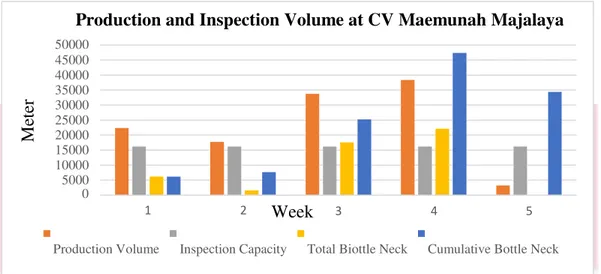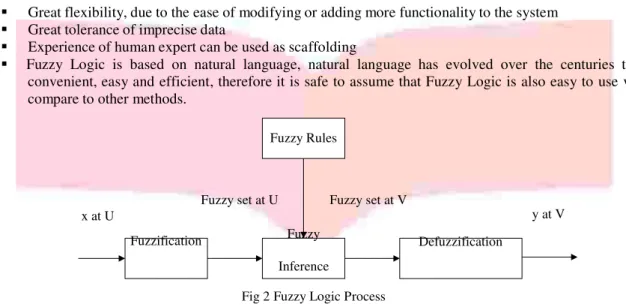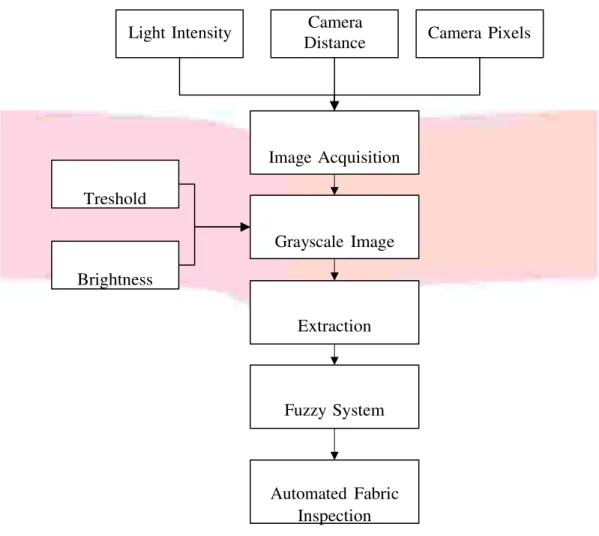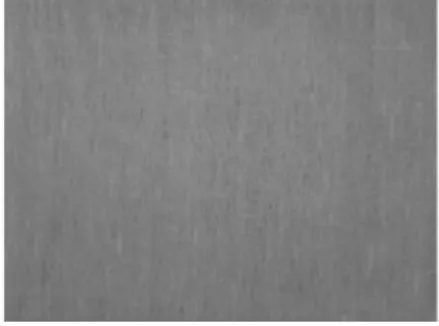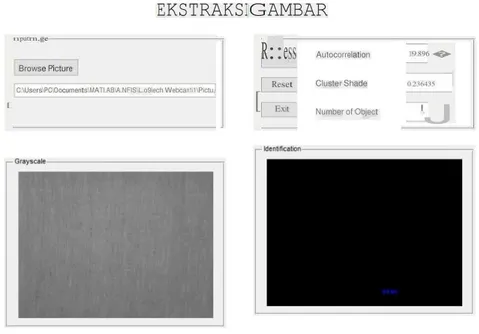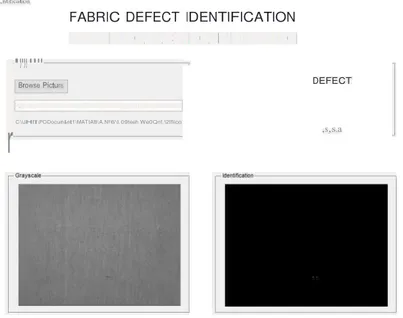OPTIMIZING WOVEN FABRIC DEFECT DETECTION FOR INSPECTION USING
IMAGE PROCESSING AND FUZZY LOGIC AT CV. MAEMUNAH MAJALAYA
Irfan Ferdyansah1, Haris Rachmat2, Denny Sukma Eka Atmaja3
1,2,3Industrial Engineering Study Program, Industrial Engineering Faculty, Telkom University
1[email protected], 2[email protected], 3[email protected]
Abstract
West Java has the largest number of textile industry in Indonesia. One of the companies that engaged in textiles is CV. Maemunah which located in the district of Ibun, Majalaya Bandung. The product of CV. Maemunah has been exported to Japan. To require fabric export best quality is needed to compete with other country. For to get the best quality of product needs to consider their quality control. In The inspection process still manually used four inspection stations with two workers in each station and average 23 second processing time needed inspection per screen. Therefore, unbalance of production volume with inspection process. The effect is bottle neck in inspection process. Inspection Process in CV. In this research proposed designing automated fabric inspection using image processing and Fuzzy Logic Model. Undertake extraction using GLCM to get value of autocorrelation, cluster shade and number of object. The proposed fabric inspection using Fuzzy Logic implemented with MATLAB provides better result in identifying fabric defect and optimizing process time. Using 35 data test produces an overall accuracy 82.86% and average process time 2.528 second. Therefore, using automated fabric inspection can decrease process time 17 second.
Keywords: Automated Fabric Inspection, Fabric Defect Detection, Image Processing, Fuzzy Logic Model
1. Introduction
Industri Tekstil dan Produk Tekstil (TPT) in Indoensia has an important role in improving the economy of
Indonesia, as a foreign exchange earner in the export of non-oil sector [1]. In 2014 Indonesia contributed $ 12.72 billion of the GDP from non-oil industry. Currently Indonesia dominates for 2% of the textile trade world. By expand for export destination to the United States and the European Union, an estimated 2015 value of textile export reached 5%.
In order to fulfil export demand in the field of textile industry and clothing required product quality that can compete with other countries. To get the best quality of product needs to consider their quality control process. In the quality control process, it needs an inspection process that aims to fulfil the test method and assessment of defect and woven fabric that fits on SNI 08-0277-1989 standard.
Currently in Indonesia fabric inspection process is traditionally using human vision. This technique can only detect fabrics to 70% [2]. The inspection process is traditionally being certainly very difficult and requires a relatively long time, because of the limitations on human vision and the differences perception between person [3]. Increasingly development of technology and image processing are now widely used in helping to resolve problems in the inspection process.
To fulfill export standard CV. Maemunah divided the fabric into three grades. The first is grade A product quality that is less than 70 points defect, the second is a non-standard grade same with grade A but the length less than qualification request, the both grade are able to fulfill export standard. And the third is grade C with defect more than 70 points.
In the inspection process still manually using four inspection stations with two workers in each station. In the inspection process of each station is only capable of performing inspection by an average 30 m fabric per hour. Based on Fig. 1 the production volume is more than 20,000 m every week and can not all be inspected. So the effect is the accumulation on the inspection process and delays in the delivery process.
M
eter
Production and Inspection Volume at CV Maemunah Majalaya
50000Fig 1 Production and inspection volume on January 2015
2. Literature Review 2.1 Textile Industry
The Indonesian TPT sector divided by three sectors, there are upstream, midstream, and downstream. Upstream industry involves producers of input (cotton, acrylic, rayon fiber, polyester) for non-woven manufacturing, spinning and weaving industry. Output of midstream TPT industry are processed by garment and polyester manufactures. Illustrated shown in Table 1
Table 1 Industrial Structure of TPT in Indonesia
Industry Structure Sector Industrial Characteristics
technology, Very high energy, Product natural fiber, synthetic fiber, rayon fiber.
Semi-capital, modern technology, workforce is larger, high energy absorption, product thread, yarded fabric (woven & knitted), and finishing fabric
Labor-intensive, growing technology, high flexibility with various end-product consumers, product clothing, pillow sheet, curtains, blankets, car seats, tents, carpets, etc.
2.2 Quality of textile
Defects in the fabric is a disorder that appears on the surface of the fabric visually. Acc ording to ISO 08-0277- 1989 defects in the fabric are grouped into seventeen types of fabric disability groups. This is nep, slub, benang
tidak rata, broken yarn, tense or loose yarns, crease, line-shaped lusi, line-shaped pakan, pattern false, bare, belang,
broke, unwoven yarn, stain, width defect, pakan bias, edge defect.
2.3 Gray Level Co-occurrence Matrix
Control
System Process
2.4 Fuzzy Logic System
Fuzzy Logic system has been used problem solving such as control, pattern identification, and image processing. Applying a Fuzzy Logic approach to an image processing system brings Fuzzy Logic properties such as [5]: The block diagram of the fuzzy logic process is shown in the Fig. 2
Great flexibility, due to the ease of modifying or adding more functionality to the system
Great tolerance of imprecise data
Experience of human expert can be used as scaffolding
Fuzzy Logic is based on natural language, natural language has evolved over the centuries to be convenient, easy and efficient, therefore it is safe to assume that Fuzzy Logic is also easy to use when compare to other methods.
Fuzzy Rules
x at U
Fuzzy set at U
Fuzzification Fuzzy
Fuzzy set at V
Defuzzification
y at V
Inference
Fig 2 Fuzzy Logic Process
2.5 Automation System
Automation is the technology which can perform a series of process or procedure automatically without human assistance. It implemented with execute a list program of instruction which combined by a control system in perform the instruction [6]. Automated system builds from three basic elements such as power, program, and control system illustrated in Fig. 3
Power
Program of Instructions
Fig 3 Elements of automated system
1. Power
Power is basic element which is required and used to operate some process and drive all of the component in the automation system.
2. Program of Instruction
Program of instruction is element required to operate control of the process from list of program and used to direct the operational of automated system.
3. Control System
Control system is an element to execute program of instruction and to accomplish the process from each automation elements.
3. Research Methodology
Light Intensity
Camera
Distance
Camera Pixels
Image Acquisition
Treshold
Grayscale Image
Brightness
Extraction
Fuzzy System
Automated Fabric
Inspection
Fig 4 Conceptual Model of Research
Image acquisition process is the first step in vision system. This step can be affected by many factors, such as as light intensity, camera distance, and camera pixels. To setup these factors according to previous research is using focus in Design of Experiment (DoE).
The next step is converted into grayscale from RGB (Red, Green, Blue). This step uses two factors from Design of Experiment, there are threshold and contrast. Contrast in this research uses +47.
After converting in grayscale image, the next step is extraction image using GLCM (Gray Level Co-Occurrence Matrix). Feature extraction is a feature-taking process which describes the characteristic of the image. From GLCM we calculate the following attributes:
i. Autocorrelation: uses to known correlation between two different variables. ii. Cluster Shade: to gauge of the skewness of the matrix and uniformity
Use edge detection to mark defect and account the number:
iii. Number of Object: uses image segmentation to calculate the number of labels in an image.
The next step is make fuzzy system [7]
1. Fuzzification, is the crisp values that are transformed into grade of membership for fuzzy sets, the crisp input values are tabulated shown in Table 2.
Table 2 Crisp Input Variables
Data Range Autocorrelation 18.9804 – 24.1985
2. Inference, the truth value for the premise of each rule is computed, and applied to the conclusion part of each rule. This result in one fuzzy subset to be assigned to each output variable for each rule.
3. Defuzzification, is used to convert the fuzzy output set to a crisp number.
The last step to design automated fabric inspection is integrated image processing using fuzzy logic model, automation, human machine interface and database.
4. Result and Discussion 4.1 Fuzzy Logic Model
In this research, the textile defect identification captures digital fabric images, as shown in Fig. 5, by image acquisition (light intensity 463 lux, 8 megapixels, and 20 cm camera distances).
Fig 5 Original Defect (broken yarn) Fabric
Next step, to removes noise and then applies convert RGB (Red Green Blue) to grayscale image, illustrated in Fig.6
Fig 6 Grayscale image
After that convert grayscale image into binary image, illustrated in Fig. 7 Where blue is defect (broken yarn).
Fig 7 Binary Image
IJ got• x
EKS
T
RAKS
I
GAMBAR
nputrn,ge
Browse Picture
C:\Users\PC\Oocuments\MATl.AB\A.NFIS\L.o9iech Webcan1i1\Pictu,1 [ membership function to definition group fuzzy set shown in Table 3
Table 3 Result form extraction feature
Data Result Membership function Fuzzy set
Autocorrelation 19.8961 0.6576 �7
Cluster Shade 0.236435 0.7541 �3
Number of Object 4 0.524 �3
Fabric Identification Defect 𝑉�������𝑡
Based on Table 1 then the rules are from the extraction is:
“If autocorrelation is �7 AND cluster shade is �3 AND number of object is �3 THEN fabric identification is
𝑉�������𝑡”
Variable input as antecedent and variable output as consequent. If they have same antecedent but difference consequent optimizing rules is needed with choose the biggest multiply membership function. In this research have 729 rules.
4.2 Defect Detection
r
II id,ntification x
.
,.,,
....
Browse Picture
FABRIC DEFECT IDENTIFICATION
DEFECT
C·\IJHfl\PODocum&nt1\MATtAB\A.NF6\l.09teeh We0Qnf,12lflico
,s,s,a
Fig 9 Result fabric defect identification
5. Conclusion
Fabric inspection is an important aspect to get best quality. For a long time, the fabric inspection process is still carried out with human vision, and thus make relatively perception. Therefore, automatic fabric inspection using image processing is required to reduce time and increase accuracy. Automated fabric inspection method and image processing using fuzzy logic with GLCM extraction to get autocorrelation, cluster shade, and number of object is proposed. Thus the proposed fabric inspection using Fuzzy logic implemented with MATLAB provides better result in identifying fabric defect. Textural features play a major role in determining the accuracy of identification. The above proposed system obtained an overall accuracy 82.86% and average process time 2.528 second of by considering 3 variable feature extraction. This is decrease 17 second from existing process.
6. References
[1] Kemenperin. 2015. Kementerian Perindustrian Republik Indonesia
[2] Wen, Z. (2013). Fabric Defects Detection using Adaptive Wavelets. International Journal of Clothing Science
and Technology, 26(3), 1.
[3] Atmaja, D. S. (2015). Optimasi Pengukuran Dimensi & Cacat Permukaan Ubin Keramik Menggunakan Pengolahan Citra Digital dan Full Factorial Design. In Optimasi Pengukuran Dimensi & Cacat Permukaan
Ubin Keramik Menggunakan Pengolahan Citra Digital dan Full Factorial Design (p. 1). Yogyakarta:
Universitas Gajah Mada.
[4] Kumar, N., & Ragupathy. (2012). An Intelligent Scheme for Fault Detection in Textile Web Materials.
International Journal of Computer Applications, 28.
[5] Amza, Catalin Gheorghe. (2014). Industrial Image Processing Using Fuzzy-Logic. international Symposium
on Intelligent Manufacturing and Automation, 100(496)
[6] Groover, M. P. (2001). Otomasi, Sistem Produksi, dan Computer-Integrated Manufacturing. New Jersey: Pearson.
